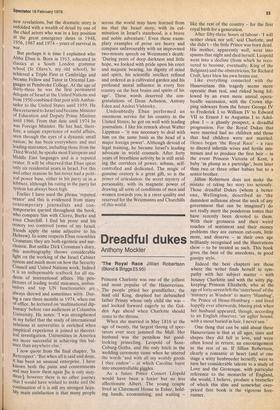Dreadful dukes
Anthony Mockler
The Royal Race Jillian Robertson (Blond & Briggs 25.95) Princess Charlotte was one of the jolliest and most popular of the Hanoverians. The people pitied her grandfather, the mad old King, despised her debauched father Prinny whose only child she was — and looked forward eagerly to the Golden Age ahead when Charlotte should come to the throne.
When she married in May 1816 at the age of twenty, the largest throng of spectators ever seen jammed the Mall. Her husband was the penniless but goodlooking princeling, Leopold of SaxeCoburg-Gotha, and the only hitch in the wedding ceremony came when he uttered the words 'and with all my worldy goods I thee endow' — at which Caroline burst into uncontrollable giggles.
As a future Prince Consort Leopold would have been a foxier but no less affectionate Albert. The young couple lived at Claremont House in Esher, holding hands, economising, and waiting — like the rest of the country — for the first royal birth for a generation.
After fifty-three hours of labour'I will neither shriek nor yell,' said Charlotte, and she didn't — the little Prince was born dead.
His mother, apparently well, went into spasms that night and died herself. Leopold went into a decline (from which he recovered to become, eventually, King of the Belgians) and the obstretrician, Sir Richard Croft, later blew his own brains out.
Like everything connected with the Hanoverians this tragedy seems more operatic than real, and risked being followed by an even more unreal operabouffe succession, with the Crown slipping sideways from the future George IV to Frederick I to William IV to Edward VII to Ernest I to Augustus I to Adolphus I — a ghastly prospect, a dreadful progression. For the Royal Dukes that were married had no children and those that had children were not married. Hence began 'the Royal Race' — a race to discard infertile wives and fertile mistresses and to produce the first heir — in the event Princess Victoria of Kent, a baby 'as plump as a partridge', born later than two or three other babies but to a senior brother.
Jillian Robertson does not make the mistake of taking her story too seriously. Those dreadful Dukes (whom a better one, Wellington, described as 'the damndest millstone about the neck of any government that can be imagined') do not really merit the ponderous tomes that have recently been devoted to them. With their groSsness and their. weird touches of sentiment and their money problems they are cartoon cut-outs, little more, and deserve — as their own age brilliantly recognised and the illustrations show — to be treated as such. This book gives the best of the anecdotes, in good gossipy style.
Indeed the best chapters are those where the writer •finds herself in sympathy with her subject matter — with bouncy Charlotte and with the witty pigkeeping Princess Elizabeth, who at the age of forty-seven left the 'sisterhood' of the 'nunnery at Windsor' to marry 'Humbug', the Prince of Hesse-Homburg — and lived happily ever afterwards, blusing pink when her husband appeared, though, according to an English observer, 'an uglier hound, with a snout buried in hair, I never saw.'
One thing that can be said about these Hanoverians is that at all ages, sizes and shapes they did fall in love, and were often loved in return, an encouragement to the rest of us. If Jillian Robertson, clearly a romantic at heart (and at one stage a witty henbreeder herself), were to turn her considerable talents to a study of Love and the Grotesque, with particular reference to the monarchs of England, she would, I believe, produce a bestseller of which this slim and somewhat overpriced first book is the vigorous forerunner.


































 Previous page
Previous page